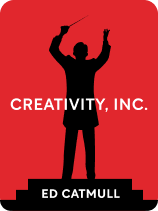

This article is an excerpt from the Shortform book guide to "Creativity, Inc." by Ed Catmull. Shortform has the world's best summaries and analyses of books you should be reading.
Like this article? Sign up for a free trial here .
What is the Creativity, Inc. book about? What lessons does Ed Catmull share from his experience leading Pixar?
The Creativity, Inc. book is the story of Pixar’s journey as a part of Lucasfilm to its growth as an independent company, and culminating with it becoming part of Disney. The book also shares the model for Pixar’s success as a creative workplace.
Read more about the Creativity, Inc. book and the lessons it offers for businesses built on creativity.
Overview of the Creativity, Inc. Book
When Ed Catmull, co-founder of Pixar Animation Studios, started his career, he had one goal: Create films using computer-generated animation. Despite a multitude of challenges, Catmull worked tirelessly to advance the technology of computer animation and, eventually, co-founded Pixar to marry his love of animation with his expertise in computer technology.
Through the journey of Pixar’s creation, Catmull developed leadership strategies that fostered creativity in the workplace while ensuring that the company remained profitable and successful. In the Creativity, Inc. book, Catmull breaks down the most important factors in building and sustaining a creative culture. From removing fear from failure and protecting new ideas, Catmull explains the ways Pixar’s creative culture allowed it to grow into the animation behemoth it is today.
Supporting a Creative Team
As Pixar solidified itself as a premier animation studio, Catmull discovered the keys that made his company stand out from the rest. He shared these keys in the Creativity, Inc. book: promoting candor in the workplace, embracing failure, and protecting new ideas.
Promoting Candor
Candor is willingness to be forthright about issues, concerns, ideas, and anything else on your mind. Candor allows teams to get straightforward feedback to improve their final product. This helps employees find flaws that they may have been blind to and get suggestions to move forward.
To make employees feel comfortable sharing their opinions, develop a judgment-free environment that allows employees to speak up. At Pixar, Catmull used Braintrust Meetings, where members of Pixar sat down to watch reels and discuss issues with a project’s creative team.
To develop a respectful and comfortable feedback session, follow these tips:
- Involve people from different departments. This will introduce a variety of perspectives.
- Promote the use of “good notes,” which expose a flaw without attacking the person, being insulting, or making a demand.
- In meetings, don’t abuse your higher position. Don’t make demands of your creative teams. Instead, offer suggestions on ways to move forward and allow the head of a project to find the best way to implement feedback.
Embracing Failure
Failure is essential to a creative workplace. Without it, you can’t discover or foster new ideas because innovation requires risk. If you don’t take risks, your final product will likely be unoriginal. However, failure is hard to embrace.
As a leader, you can take the stigma out of failure by admitting your own failures. Explain what you learned from them, and how you moved forward. This will help your employees embrace and learn from their own failures.
Failure has two parts: the failure itself and how you respond to it. If you learn from your mistakes, it can help you grow and develop. Taking the time to analyze why you failed allows you to avoid similar mistakes in the future.
Knowing When to Let Go
While failure is a necessary element of creative success, consistent failure can destroy a project or organization. If a team doesn’t seem to be learning from their mistakes, you will eventually have to pull the plug on a project or remove the people who aren’t growing. If this happens, take the time to analyze why this project or person failed to learn from their mistakes. This will give you insight when it comes time to start a new project or hire a new team member.
Protecting New Ideas
When searching for a new concept to work with, it’s easy to look for flaws that can lead you to abandon or dismiss a project. While critique and feedback are essential to growth, the best way to find a new project is to look for what makes it exciting instead of what makes it problematic. It can be risky to endorse an unproven idea, but, often, those are the projects that produce the best results.
When these new concepts are introduced, they’re often messy and incomplete. In this state, it’s easy to pass judgment on them then toss them aside. However, as a leader in a creative organization, it’s your job to protect and nurture these concepts until they grow into fully-fledged creations. New ideas are risky and messy because of their originality, but that’s what gives them the potential to become spectacular.
Finding Balance
In a creative company, you have to balance the need to innovate with the need to produce. There isn’t one clear-cut way to ensure balance in your organization. However, one rule-of-thumb may help: Don’t let one team or person get everything they want.
Each department in your organization wants different things. These “wants” sometimes conflict with one another but also help keep teams in check. If one team gets everything that they want, it throws the company out of balance. For example, if you’re leading a film studio, giving the creative team everything they want may lead to a bloated and over-budget film that’s too niche to sell. On the other hand, giving the marketing team everything they want may lead to an unoriginal and predictable film that appeals to the lowest common denominator.
Eight Tools From the Creativity, Inc. Book
People’s perspective on the world often distorts what’s right in front of them. In regards to creativity, this limited perspective often leads to inflexibility. People become convinced that their perspective is the correct perspective, and they ignore new information that contradicts their view. When you get together a team of dozens or hundreds of people, this inflexibility can stall a creative process.
To ensure that your team doesn’t fall into this inflexibility, create opportunities for them to expand their worldview and interact with people who have different perspectives. The following are eight tools from the Creativity, Inc. book that you can use to help your team maintain their creative spark and challenge their own perspectives:
- Hold Frequent Feedback Meetings. These sessions allow your team members to get different perspectives on the work that they’re doing. This prevents your employees from becoming overly committed to their work and allows them to solve problems collaboratively. Frequent feedback also allows your team to fix potential problems early on instead of after they’ve put dozens or hundreds of hours into a project.
- Promote Research. Research is essential to creation. Learning more about the subject of your creative project enables you to produce a more realistic product. For example, if you want to create a film about living with a dog, you would need to understand what it’s like to have a pet. If you haven’t researched the topic or had any experiences with a pet, your film probably won’t be accurate.
- Create Clear Boundaries. Though it may seem counterintuitive, creating boundaries for your teams can actually promote creativity in addition to efficiency. It forces them to approach challenges in a unique way and focus on the most important elements of the project. In fact, creative solutions can actually produce stronger results than the initial plan.
- Combine Art with Technology. Technology can inspire creativity. As technology continues to improve, artists can develop projects in a wholly original way. For example, Pixar used new computer technologies to create films unlike anything anyone had ever seen before.
- Create an Experimental Space. Experimental projects give you a space to take risks without the pressure of making a profit. They allow your organization to explore new ideas, find better ways of working, and give employees with potential more experience.
- Put Aside Your Preconceived Notions. The human brain likes to simplify our surroundings so that they’re easier to process. However, this simplification leads people to jump to conclusions that aren’t entirely accurate. For example, when an artist learns to pay attention to the details of an object, they have to let go of any preconceived notions they may have about the subject. Rather than just painting a lake blue, they become attuned to the small flecks of green, yellow, and white that reflect off of the top of a river. This attention to detail allows them to create a more fully realized version of their surroundings.
- Use Postmortems. Postmortems are meetings that occur after a project is completed in which you discuss the process as a whole. This allows you and your team to speak out about what’s working and what’s not. These postmortems should occur relatively quickly following the end of a project while the process is still fresh in everyone’s mind. They allow you to reflect on what you’ve learned and let you prepare for future projects.
- Build Learning Opportunities and Team-Bonding Experiences. Creating learning opportunities for your team members keeps them open to new experiences. They keep your team members in the mindset of a student as they tackle new subjects. Also, it helps members of your organization bond in a way that they can’t during a typical work day. Being a student puts everyone on the same playing field, regardless of hierarchical level.

———End of Preview———
Like what you just read? Read the rest of the world's best book summary and analysis of Ed Catmull's "Creativity, Inc." at Shortform .
Here's what you'll find in our full Creativity, Inc. summary :
- How Pixar went from selling computers to successful animation studio
- What it takes to build a creative workplace culture
- Why George Lucas sold Pixar to Steve Jobs






